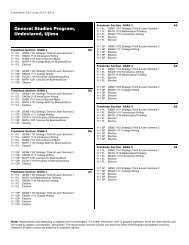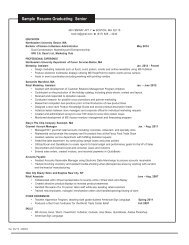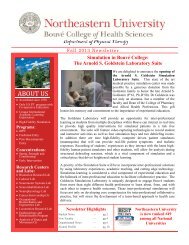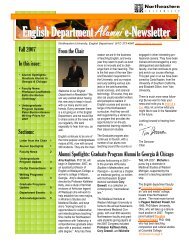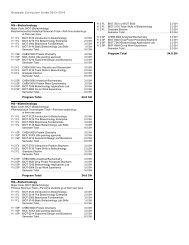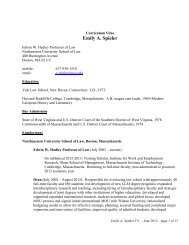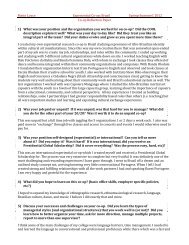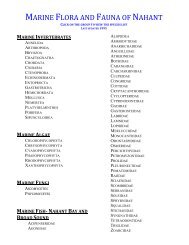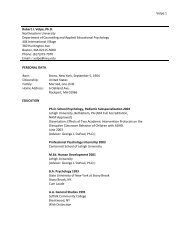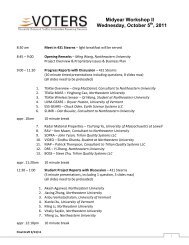Giant Electric Field Tuning of Magnetism in Novel Multiferroic FeGaB ...
Giant Electric Field Tuning of Magnetism in Novel Multiferroic FeGaB ...
Giant Electric Field Tuning of Magnetism in Novel Multiferroic FeGaB ...
You also want an ePaper? Increase the reach of your titles
YUMPU automatically turns print PDFs into web optimized ePapers that Google loves.
www.advmat.de<br />
<strong>Giant</strong> <strong>Electric</strong> <strong>Field</strong> <strong>Tun<strong>in</strong>g</strong> <strong>of</strong> <strong>Magnetism</strong> <strong>in</strong> <strong>Novel</strong><br />
<strong>Multiferroic</strong> <strong>FeGaB</strong>/Lead Z<strong>in</strong>c Niobate–Lead Titanate<br />
(PZN-PT) Heterostructures<br />
By J<strong>in</strong>g Lou, M<strong>in</strong>g Liu, David Reed, Yuhang Ren, and Nian X. Sun*<br />
<strong>Multiferroic</strong> composite materials consist<strong>in</strong>g <strong>of</strong> both a magnetic<br />
phase and a ferroelectric phase are <strong>of</strong> great current <strong>in</strong>terest, as<br />
they <strong>of</strong>fer the possibility <strong>of</strong> magnetoelectric (ME) coupl<strong>in</strong>g, that is,<br />
electric field manipulation <strong>of</strong> magnetic properties (converse ME<br />
effect) or vice versa (direct ME effect), [1–4] and have led to many<br />
novel multiferroic devices. [5–12] One important series <strong>of</strong> such<br />
multiferroic devices is constituted by electrostatically tunable<br />
microwave multiferroic signal process<strong>in</strong>g devices, <strong>in</strong>clud<strong>in</strong>g<br />
tunable resonators, [9] phase shifters, [10] and tunable filters. [11,12]<br />
Compared to conventional tunable microwave magnetic devices,<br />
which are tuned by magnetic fields, these electrostatically tunable<br />
microwave multiferroic devices are much more energy efficient,<br />
less noisy, compact, and lightweight.<br />
ME effects can be realized <strong>in</strong> multiferroic composites through<br />
a stra<strong>in</strong>/stress-mediated <strong>in</strong>teraction, [1–5,7–14] which enables<br />
effective energy transfer between electric and magnetic fields<br />
and leads to important new functionalities and devices. Strong<br />
ME coupl<strong>in</strong>g is critical for multiferroic devices; however, it has<br />
been difficult to achieve at microwave frequencies, lead<strong>in</strong>g to a<br />
very limited tunability <strong>in</strong> electrostatically tunable microwave<br />
multiferroic devices. The demonstrated tunable range <strong>of</strong> most <strong>of</strong><br />
these devices has been very limited, with a frequency tunability<br />
<strong>of</strong> Df < 150 MHz and a low tunable magnetic field <strong>of</strong><br />
DH < 50 Oe [9–12] (1 Oe 79.6 A m 1 ). This is ma<strong>in</strong>ly due to the<br />
large loss tangents at microwave frequencies <strong>of</strong> the two<br />
constituent phases, that is, the ferroelectric phase and,<br />
particularly, the magnetic phase, which is less resistive. The<br />
ME coupl<strong>in</strong>g strength <strong>in</strong> multiferroic composites is determ<strong>in</strong>ed<br />
by many factors, such as the properties <strong>of</strong> the two constituent<br />
phases, the <strong>in</strong>terface between them, the mode <strong>of</strong> ME coupl<strong>in</strong>g,<br />
and the orientation <strong>of</strong> the magnetic and electric fields. As a result,<br />
layered multiferroic heterostructures with magnetic th<strong>in</strong> films<br />
provide great opportunities for achiev<strong>in</strong>g strong ME coupl<strong>in</strong>g at<br />
microwave frequencies, ow<strong>in</strong>g to m<strong>in</strong>imized charge leakage<br />
paths and low loss tangents associated with magnetic th<strong>in</strong> films.<br />
It is also desirable for the magnetic phase <strong>in</strong> the multiferroic<br />
composites to have a narrow ferromagnetic resonance (FMR)<br />
[*] Pr<strong>of</strong>. N. X. Sun, J. Lou, M. Liu, D. Reed<br />
Department <strong>of</strong> <strong>Electric</strong>al and Computer Eng<strong>in</strong>eer<strong>in</strong>g<br />
Northeastern University<br />
Boston, MA 02115 (USA)<br />
E-mail: nian@ece.neu.edu<br />
Pr<strong>of</strong>. Y. H. Ren<br />
Department <strong>of</strong> Physics and Astronomy<br />
Hunter College, City University <strong>of</strong> New York<br />
New York, NY 10065 (USA)<br />
DOI: 10.1002/adma.200901131<br />
l<strong>in</strong>ewidth and a large piezomagnetic coefficient (dl/dH), that is, a<br />
large saturation magnetostriction constant (ls) and a low<br />
saturation magnetic field (Hs). However, such magnetic materials<br />
have not been readily available.<br />
Very recently, we have reported a new class <strong>of</strong> metallic<br />
magnetic <strong>FeGaB</strong> films that has a high ls <strong>of</strong> ca. 70 ppm, a low Hs <strong>of</strong><br />
ca. 20 Oe, and a narrow FMR l<strong>in</strong>ewidth <strong>of</strong> ca. 16 Oe at X-band (ca.<br />
9.6 GHz). [15] The maximum piezomagnetic coefficient <strong>of</strong> the<br />
<strong>FeGaB</strong> films is about 7 ppm Oe 1 , which is much higher than<br />
those <strong>of</strong> other well-known magnetostrictive materials used <strong>in</strong><br />
multiferroic composites, such as Terfenol-D (Tb-Dy-Fe), [16]<br />
Galfenol (Fe-Ga), [17] and Metglas (FeBSiC), [18] as shown <strong>in</strong><br />
Figure 1. The comb<strong>in</strong>ation <strong>of</strong> narrow FMR l<strong>in</strong>ewidth and high<br />
piezomagnetic coefficient makes these <strong>FeGaB</strong> films excellent<br />
candidates for the magnetic material <strong>in</strong> microwave multiferroic<br />
composites. [19,20]<br />
S<strong>in</strong>gle-crystal ferroelectrics such as lead magnesium niobate–lead<br />
titanate (PMN-PT) [21] and lead z<strong>in</strong>c niobate–lead titanate<br />
(PZN-PT) [22] hav<strong>in</strong>g giant piezoelectric coefficients and low loss<br />
tangents are desired for microwave multiferroic composites as<br />
well. In particular, (011)-cut PMN-PT and PZN-PT s<strong>in</strong>gle-crystal<br />
slabs have anisotropic piezoelectric coefficients d31 and d32 when<br />
poled along their [011] crystall<strong>in</strong>e direction. For example,<br />
(011)-cut PZN-PT s<strong>in</strong>gle crystals with 6% lead titanate have high<br />
anisotropic piezoelectric coefficients d31 ¼ 3000 pC N 1 and<br />
d32 ¼ 1100 pC N 1 . [22] The giant anisotropic piezoelectric coefficients<br />
<strong>of</strong> the PZN-PTs<strong>in</strong>gle crystal provide great opportunities for<br />
generat<strong>in</strong>g a large <strong>in</strong>-plane magnetic anisotropic field and<br />
Figure 1. Piezomagnetic coefficients (dl/dH) <strong>of</strong> different types <strong>of</strong> magnetostrictive<br />
alloys.<br />
Adv. Mater. 2009, 21, 4711–4715 ß 2009 WILEY-VCH Verlag GmbH & Co. KGaA, We<strong>in</strong>heim 4711<br />
COMMUNICATION
COMMUNICATION<br />
therefore large frequency tunability <strong>in</strong> multiferroic composites.<br />
[20]<br />
In this Communication, we report on novel <strong>FeGaB</strong>/PZN-PT<br />
heterostructures that exhibit a record high electrostatically<br />
tunable FMR frequency range <strong>of</strong> 5.82 GHz or fmax/fm<strong>in</strong> ¼ 4.3,<br />
and a giant electrostatically <strong>in</strong>duced magnetic anisotropy field <strong>of</strong><br />
ca. 750 Oe at both dc and microwave frequencies. This<br />
corresponds to a large mean ME coupl<strong>in</strong>g coefficient <strong>of</strong><br />
94 Oe cm kV 1 and a giant mean electrostatically tunable<br />
frequency coefficient <strong>of</strong> 970 MHz cm kV 1 . Specifically, at the<br />
phase transition region <strong>of</strong> the PZN-PT s<strong>in</strong>gle crystal, a colossal<br />
ME coupl<strong>in</strong>g coefficient <strong>of</strong> 2365 Oe cm kV 1 and a giant<br />
electrostatically tunable frequency coefficient <strong>of</strong><br />
15 GHz cm kV 1 are achieved. These parameters are about<br />
1–3 orders <strong>of</strong> magnitude higher than published values. [9–14,19,20]<br />
The <strong>FeGaB</strong>/PZN-PT multiferroic heterostructures with giant<br />
electrostatically tunable frequencies and magnetic anisotropy<br />
fields provide great opportunities for electrostatically tunable<br />
microwave signal process<strong>in</strong>g devices.<br />
<strong>Multiferroic</strong> heterostructures <strong>of</strong> <strong>FeGaB</strong>/PZN-PT were made by<br />
direct deposition <strong>of</strong> 100 nm <strong>FeGaB</strong> films us<strong>in</strong>g a magnetron<br />
sputter<strong>in</strong>g method (see the Experimental section) onto PZN-PT<br />
s<strong>in</strong>gle crystal slabs, as schematically shown <strong>in</strong> Figure 2. The<br />
<strong>FeGaB</strong> film had a magnetic easy axis that was <strong>in</strong>duced dur<strong>in</strong>g<br />
deposition by a bias magnetic field, which was oriented along the<br />
<strong>in</strong>-plane [001] direction <strong>of</strong> the PZN-PT s<strong>in</strong>gle crystal to ensure<br />
maximum frequency tunability. <strong>Electric</strong> fields were applied across<br />
the thickness direction <strong>of</strong> the PZN-PT s<strong>in</strong>gle crystal <strong>in</strong> order to<br />
utilize its high anisotropic piezoelectric coefficients d31 and d32,<br />
which are also shown <strong>in</strong> Figure 2.<br />
The field-sweep FMR spectra <strong>of</strong> the <strong>FeGaB</strong>/PZN-PT multiferroic<br />
heterostructure under different electric fields are shown <strong>in</strong><br />
Figure 3. The external magnetic field was applied parallel to the<br />
<strong>in</strong>-plane [011] direction <strong>of</strong> the PZN-PT s<strong>in</strong>gle crystal, and was<br />
swept between 0 and 1400 Oe. Clearly, the FMR spectra changed<br />
dramatically with the external electric field, <strong>in</strong>dicat<strong>in</strong>g a giant ME<br />
coupl<strong>in</strong>g <strong>in</strong> the <strong>FeGaB</strong>/PZN-PT heterostructure. The FMR field<br />
(the external magnetic field at which the power absorption<br />
spectrum dI/dH crosses zero, i.e., maximum power absorption)<br />
shifted from 1172 to 898 Oe on chang<strong>in</strong>g the external electric field<br />
from 2 to 5.8 kV cm 1 . A sudden change <strong>of</strong> the FMR field from<br />
898 to 425 Oe occurred at electric fields between 5.8 and 6 kV<br />
cm 1 . Such a dramatic change <strong>of</strong> the FMR field with<strong>in</strong> a very<br />
narrow electric field range is closely related to the phase transition<br />
Figure 2. Scheme show<strong>in</strong>g the structure <strong>of</strong> the <strong>FeGaB</strong>/PZN-PT multiferroic<br />
heterostructure. The coord<strong>in</strong>ate system shows the crystall<strong>in</strong>e directions<br />
<strong>of</strong> the PZN-PT s<strong>in</strong>gle crystal.<br />
www.advmat.de<br />
Figure 3. <strong>Electric</strong> field dependence <strong>of</strong> the <strong>in</strong>-plane field-sweep FMR spectra<br />
<strong>of</strong> the <strong>FeGaB</strong>/PZN-PT multiferroic heterostructure measured at ca.<br />
9.6 GHz.<br />
from the rhombohedral to the tetragonal phase <strong>in</strong> the PZN-PT<br />
s<strong>in</strong>gle crystal, which has been reported previously. [22] The FMR<br />
field barely changed at electric fields higher than 6 kV cm 1 ,<br />
which was also consistent with the stra<strong>in</strong>–electric field relation <strong>of</strong><br />
the PZN-PTs<strong>in</strong>gle crystal. [22] It is important to emphasize that the<br />
overall electric-field-<strong>in</strong>duced FMR field change (also the total<br />
electrostatically <strong>in</strong>duced magnetic anisotropy) is ca. 750 Oe,<br />
which is the largest value that has ever been reported,<br />
correspond<strong>in</strong>g to a mean ME coupl<strong>in</strong>g coefficient a ¼ DH/<br />
DE ¼ 94 Oe cm kV 1 . Specifically, the ME coupl<strong>in</strong>g coefficient<br />
amounts to 2365 Oe cm kV 1 at the phase transition region <strong>of</strong><br />
the PZN-PT s<strong>in</strong>ge crystal. Meanwhile, the FMR l<strong>in</strong>ewidth <strong>of</strong> the<br />
<strong>FeGaB</strong> film, which is a critical parameter for microwave magnetic<br />
materials, stays at 50 5 Oe under different electric fields. The<br />
ratio between the total tunable magnetic field and the FMR<br />
l<strong>in</strong>ewidth is as high as ca. 1500%, <strong>in</strong>dicat<strong>in</strong>g an excellent figure <strong>of</strong><br />
merit for tunable microwave devices.<br />
Very recently, Eerenste<strong>in</strong> et al. have reported a multiferroic<br />
epitaxial heterostructure <strong>of</strong> 40 nm La0.67Sr0.33MnO3 (LSMO) on a<br />
0.5 mm s<strong>in</strong>gle-crystal BaTiO 3 (BTO) substrate, [13] which showed a<br />
large ME coupl<strong>in</strong>g coefficient a ¼ m 0DM/DE ¼ 2.3 10 7 s m 1<br />
near the orthorhombic-to-rhombohedral phase transition region<br />
<strong>of</strong> the BaTiO3. It is <strong>in</strong>terest<strong>in</strong>g to note that the two ME coupl<strong>in</strong>g<br />
coefficients can be converted to the same units <strong>of</strong> seconds per<br />
meter. However, the two different methods <strong>of</strong> calculat<strong>in</strong>g ME<br />
coupl<strong>in</strong>g coefficients, that is, through a ¼ DH/DE and a ¼ m0DM/<br />
DE, represent two different physical quantities. For the LSMO/<br />
BTO heterostructure, the ME coupl<strong>in</strong>g coefficient was calculated<br />
from a ¼ m0DM/DE, which represents the electric-field-<strong>in</strong>duced<br />
magnetization change, whereas the ME coupl<strong>in</strong>g coefficient for<br />
the <strong>FeGaB</strong>/PZN-PT heterostructures <strong>in</strong> this work were calculated<br />
by a ¼ DH/DE, the effective <strong>in</strong>duced magnetic field per unit<br />
electric field, which is the electric-field-<strong>in</strong>duced effective<br />
magnetic field change.<br />
It is worth mention<strong>in</strong>g that the other widely used ME coupl<strong>in</strong>g<br />
coefficient a ¼ DP/DH, which is the electric polarization change<br />
per unit magnetic field, also has the units, seconds per meter. [7] It<br />
can be calculated from a ¼ e0 xDE/DH, where x is the electric<br />
susceptibility <strong>of</strong> the ferroelectric phase, and e0 is the permittivity<br />
4712 ß 2009 WILEY-VCH Verlag GmbH & Co. KGaA, We<strong>in</strong>heim Adv. Mater. 2009, 21, 4711–4715
www.advmat.de<br />
Figure 4. <strong>Electric</strong> field dependence <strong>of</strong> the transmission coefficient (S 21)<br />
spectra <strong>of</strong> the <strong>FeGaB</strong>/PZN-PT multiferroic heterostructure measured by<br />
network analyzer.<br />
<strong>of</strong> vacuum. Although all four ME coupl<strong>in</strong>g coefficients,<br />
a ¼ m 0DM/DE, a ¼ DH/DE, a ¼ DP/DH and a ¼ DE/DH, have<br />
been used <strong>in</strong> the literature, they represent totally different<br />
physical quantities, mak<strong>in</strong>g a mean<strong>in</strong>gful comparison difficult.<br />
The frequency-sweep FMR behavior <strong>of</strong> the <strong>FeGaB</strong>/PZN-PT<br />
multiferroic composite was also measured on a network analyzer,<br />
and is shown as the transmission coefficient S21 spectra <strong>in</strong><br />
Figure 4. The ma<strong>in</strong> absorption peak <strong>in</strong> the S 21 curves corresponds<br />
to the FMR, which shows strong electric field dependence,<br />
<strong>in</strong>dicat<strong>in</strong>g a large tun<strong>in</strong>g <strong>of</strong> the FMR frequency by electric fields.<br />
It is notable that the S21 spectra were measured without a bias<br />
magnetic field, <strong>in</strong>dicat<strong>in</strong>g that such <strong>FeGaB</strong>/PZN-PT heterostructures<br />
can be operated under a self-biased condition over a<br />
wide range <strong>of</strong> operational frequency. The lowest FMR frequency<br />
is 1.75 GHz at zero electric field and the highest is 7.57 GHz at 6<br />
or 8 kV cm 1 . The total electrostatically tunable FMR frequency<br />
range <strong>of</strong> 5.82 GHz is about two order <strong>of</strong> magnitude higher than<br />
reported values. [9–12] This leads to an electrostatically tunable<br />
range <strong>of</strong> the FMR frequency <strong>of</strong> more than 2 octaves, or<br />
fmax/fm<strong>in</strong> ¼ 4.3, correspond<strong>in</strong>g to a mean tunable frequency per<br />
unit electric field <strong>of</strong> 970 MHz cm kV 1 , or 15 GHz cm kV 1 at<br />
the phase transition region <strong>of</strong> the PZN-PT s<strong>in</strong>gle crystal. The very<br />
large frequency tunability makes these <strong>FeGaB</strong>/PZN-PT multiferroic<br />
heterostructures attractive for electrostatically tunable<br />
microwave multiferroic devices.<br />
The magnetic hysteresis loops <strong>of</strong> the <strong>FeGaB</strong>/PZN-PT multiferroic<br />
heterostructure were measured by vibrat<strong>in</strong>g-sample<br />
magnetometer (VSM) along the [100] direction <strong>of</strong> the PZN-PT<br />
s<strong>in</strong>gle crystal under different electric fields, which also confirmed<br />
the large electric-field-<strong>in</strong>duced effective magnetic anisotropy<br />
changes, as shown <strong>in</strong> Figure 5. Clearly, the electric-field-<strong>in</strong>duced<br />
magnetic anisotropy field is the largest at electric fields <strong>of</strong> 6 and<br />
8kV cm 1 , and lowest at 0 kV cm 1 . The <strong>in</strong>-plane magnetic<br />
anisotropy fields at different electric fields can be estimated from<br />
the hysteresis loops, be<strong>in</strong>g ca. 20 Oe at 0 kV cm 1 and ca. 700 Oe<br />
at 6 kV cm 1 electric field. This leads to a ME coefficient <strong>of</strong> ca.<br />
113 Oe cm kV 1 at dc, which is close to the value obta<strong>in</strong>ed from<br />
the FMR measurements at microwave frequencies.<br />
The electric-field-<strong>in</strong>duced change <strong>in</strong> the <strong>in</strong>-plane magnetic<br />
anisotropy field, DHeff, can be calculated by the piezoelectric and<br />
Figure 5. Magnetic hysteresis loops <strong>of</strong> the <strong>FeGaB</strong>/PZN-PT multiferroic<br />
heterostructure under different external electric fields measured by VSM.<br />
<strong>in</strong>verse magnetoelastic equations. S<strong>in</strong>ce the thicknesses <strong>of</strong> the<br />
<strong>FeGaB</strong> film and electrode layers are much less than that <strong>of</strong> the<br />
PZN-PT s<strong>in</strong>gle-crystal substrate, the <strong>FeGaB</strong> film experiences an<br />
<strong>in</strong>-plane stress <strong>in</strong>duced by the piezoelectric stra<strong>in</strong> <strong>of</strong> the PZN-PT<br />
s<strong>in</strong>gle crystal, lead<strong>in</strong>g to an <strong>in</strong>duced effective magnetic field <strong>of</strong><br />
(cgs units)<br />
DHeff ¼ 3lsdeff EY=Ms<br />
where Y is Young’s modulus <strong>of</strong> the <strong>FeGaB</strong> film, deff is the<br />
effective piezoelectric coefficient, E is the applied electric field,<br />
and M s is the saturation magnetization. Assum<strong>in</strong>g a plane stress<br />
condition, deff can be calculated as<br />
deff ¼ vd32 þ d31<br />
1 v 2<br />
vd31 þ d32<br />
1 v2 ¼ d31 d32<br />
1 þ v<br />
where v is the Poisson ratio <strong>of</strong> the <strong>FeGaB</strong> film. Clearly, the<br />
anisotropic piezoelectric coefficients <strong>of</strong> the PZN-PT s<strong>in</strong>gle crystal<br />
are desirable <strong>in</strong> achiev<strong>in</strong>g large electric-field-<strong>in</strong>duced magnetic<br />
anisotropy fields. The magnetic anisotropy fields <strong>in</strong>duced by ME<br />
coupl<strong>in</strong>g can therefore be estimated, with Young’s modulus <strong>of</strong><br />
about 55 GPa for the <strong>FeGaB</strong> film; they are listed <strong>in</strong> Table 1<br />
together with measured DH eff from field-sweep FMR measurements.<br />
The theoretical and experimental data show very good<br />
agreement.<br />
Table 1. Calculated and measured electric-field-<strong>in</strong>duced effective magnetic<br />
field DHeff <strong>of</strong> the <strong>FeGaB</strong>/PZN-PT multiferroic heterostructure under different<br />
electric fields.<br />
<strong>Electric</strong> field [kV cm 1 ] 0 2 4 5.8 6 8<br />
Calculated DH eff [Oe] 0 78 156 227 632 [a] 640 [a]<br />
Measured DHeff [Oe] 0 69 139 207 680 686<br />
[a] These values are estimated from the stra<strong>in</strong>–electric field curve [22] <strong>of</strong> the PZN-PT<br />
s<strong>in</strong>gle crystal s<strong>in</strong>ce its piezoelectric constant is no longer proportional to the electric<br />
field.<br />
Adv. Mater. 2009, 21, 4711–4715 ß 2009 WILEY-VCH Verlag GmbH & Co. KGaA, We<strong>in</strong>heim 4713<br />
(1)<br />
(2)<br />
COMMUNICATION
COMMUNICATION<br />
We describe the electric-field-<strong>in</strong>duced shift <strong>of</strong> the FMR field or<br />
frequency by the Landau–Lifshitz equation <strong>of</strong> motion for the<br />
magnetization. [23] The eigenfrequencies <strong>of</strong> the stand<strong>in</strong>g sp<strong>in</strong><br />
waves can be described by<br />
v 2 k ¼ g2 Hdc þ 2Kk þ DHeff þ Dk<br />
Ms<br />
2<br />
Hdc þ 2Kk þ 4pMs<br />
Ms<br />
2K?<br />
Ms<br />
þ DHeff þ Dk 2<br />
where H dc is the external magnetic field, K? and K jj are the<br />
out-<strong>of</strong>-plane and <strong>in</strong>-plane uniaxial anisotropy constants, D is the<br />
sp<strong>in</strong> stiffness, and k is the sp<strong>in</strong> wave vector.<br />
It is obvious from Equations 1–3 that the FMR frequency can<br />
be tuned by both magnetic and electric fields. Hence we are able<br />
to estimate the FMR frequency <strong>of</strong> the <strong>FeGaB</strong>/PZN-PT multiferroic<br />
heterostructure under different magnetic and electric bias<br />
fields. In order to better understand the dual tunability <strong>of</strong> the<br />
<strong>FeGaB</strong>/PZN-PT multiferroic, a three-dimensional (3D) chart for<br />
the FMR frequency versus the electric and magnetic fields was<br />
constructed and is shown <strong>in</strong> Figure 6. Clearly, the estimated FMR<br />
frequencies match the experimental data very well.<br />
It is notable that the <strong>in</strong>terface <strong>of</strong> the multiferroic heterostructures<br />
plays a crucial role <strong>in</strong> determ<strong>in</strong><strong>in</strong>g the ME coupl<strong>in</strong>g<br />
strength, as well as the resonance modes (or eigenfrequencies) <strong>of</strong><br />
<strong>FeGaB</strong> films. In addition to the FMR field shift, we notice a<br />
significant change <strong>of</strong> the l<strong>in</strong>e shape <strong>in</strong> Figure 3 when the electric<br />
field is <strong>in</strong>creased. The spectra become more asymmetric with<br />
<strong>in</strong>creas<strong>in</strong>g electric field. A relatively weak absorption peak at the<br />
lower field side <strong>of</strong> the ma<strong>in</strong> mode can be deconvoluted from the<br />
FMR spectra <strong>in</strong> Figure 3, which is attributed to the first-order<br />
stand<strong>in</strong>g sp<strong>in</strong> wave mode along the <strong>FeGaB</strong> film thickness<br />
direction. The stand<strong>in</strong>g sp<strong>in</strong> wave mode disturbs the ma<strong>in</strong><br />
Figure 6. 3D plot show<strong>in</strong>g the FMR frequency <strong>of</strong> the <strong>FeGaB</strong>/PZN-PT<br />
multiferroic heterostructure as a function <strong>of</strong> external magnetic and electric<br />
bias fields.<br />
(3)<br />
www.advmat.de<br />
resonance l<strong>in</strong>e and <strong>in</strong>troduces an additional contribution to the<br />
FMR l<strong>in</strong>ewidth as well as the asymmetric l<strong>in</strong>e shape. Such a<br />
double resonance feature can also be clearly observed <strong>in</strong> Figure 4,<br />
particularly at a high applied electric field. The appearance <strong>of</strong> the<br />
first-order stand<strong>in</strong>g sp<strong>in</strong> wave testifies to the fact that there is a<br />
free boundary condition on one <strong>of</strong> the <strong>FeGaB</strong> film surfaces, while<br />
on the other surface, that is, the <strong>in</strong>terface, the sp<strong>in</strong>s are gradually<br />
p<strong>in</strong>ned by the <strong>in</strong>creas<strong>in</strong>g stress <strong>in</strong>duced by the deformation <strong>of</strong> the<br />
PZN-PT s<strong>in</strong>gle crystal, s<strong>in</strong>ce <strong>in</strong> uniform th<strong>in</strong> films FMR selection<br />
rules allow only excitations with a net magnetic moment. In other<br />
words, asymmetric boundary conditions at the <strong>FeGaB</strong>/PZN-PT<br />
<strong>in</strong>terface are realized by electrostatically <strong>in</strong>duced ME coupl<strong>in</strong>g <strong>in</strong><br />
the <strong>FeGaB</strong>/PZN-PT heterostructure, which is responsible for the<br />
excitation <strong>of</strong> stand<strong>in</strong>g sp<strong>in</strong> waves.<br />
In conclusion, novel <strong>FeGaB</strong>/PZN-PT multiferroic heterostructures<br />
have been synthesized and characterized. A large<br />
electric-field-<strong>in</strong>duced effective magnetic anisotropy field <strong>of</strong> ca.<br />
750 Oe with a narrow FMR l<strong>in</strong>ewidth <strong>of</strong> ca. 50 Oe was observed at<br />
X-band <strong>in</strong> the <strong>FeGaB</strong>/PZN-PT heterostructure, which was<br />
consistent with the observed effective magnetic field change at<br />
dc. The <strong>FeGaB</strong>/PZN-PT heterostructure exhibited a large mean<br />
ME coupl<strong>in</strong>g coefficient a ¼ DH/DE ¼ 94 Oe cm kV 1 , and a<br />
giant ME coupl<strong>in</strong>g coefficient <strong>of</strong> 2365 Oe cm kV 1 at the<br />
electric-field-<strong>in</strong>duced phase transition region <strong>of</strong> the PZN-PT<br />
s<strong>in</strong>gle crystal. The heterostructures also showed a large<br />
electric-field-tunable FMR frequency range between 1.75 and<br />
7.57 GHz under zero bias magnetic field, correspond<strong>in</strong>g to a<br />
mean tunable frequency per unit electric field <strong>of</strong> about<br />
970 MHz cm kV 1 . The FMR frequency tunability was as high<br />
as 15 GHz cm kV 1 at the PZN-PT phase transition region. The<br />
giant tunable magnetic field and FMR frequency <strong>of</strong> the <strong>FeGaB</strong>/<br />
PZN-PT multiferroic heterostructures make them promis<strong>in</strong>g<br />
candidates for wide-band electrostatically tunable microwave<br />
devices.<br />
Experimental<br />
Materials and Methods: <strong>Multiferroic</strong> heterostructures <strong>of</strong> <strong>FeGaB</strong>/PZN-PT<br />
were fabricated by direct deposition <strong>of</strong> bilayers <strong>of</strong> Ni 80Fe 20 (Permalloy)/<br />
<strong>FeGaB</strong> films onto commercially available (011)-cut and [011]-poled<br />
PZN–6%PT s<strong>in</strong>gle-crystal slabs with a thickness <strong>of</strong> 0.5 mm. The Permalloy<br />
layer, which had a thickness <strong>of</strong> ca. 5 nm, was used as a seed layer for<br />
achiev<strong>in</strong>g better magnetic s<strong>of</strong>tness and narrow FMR l<strong>in</strong>ewidth [24]. The<br />
<strong>FeGaB</strong> films used <strong>in</strong> this work have a saturation magnetization <strong>of</strong> ca. 10 kG<br />
(1 kG ¼ 0.1 T), an <strong>in</strong>itial relative permeability mi <strong>of</strong> ca. 400, and a saturation<br />
magnetostriction constant <strong>of</strong> ca. 60 ppm.<br />
An electron paramagnetic resonance spectrometer operat<strong>in</strong>g at X-band<br />
(ca. 9.6 GHz) with a TE102 microwave cavity was used to characterize the<br />
microwave performance <strong>of</strong> the <strong>FeGaB</strong>/PZN-PT heterostructures. The dc<br />
magnetic field was applied <strong>in</strong> the film plane and parallel to the [011]<br />
direction <strong>of</strong> the PZN-PT s<strong>in</strong>gle crystal while the magnetic component <strong>of</strong> the<br />
microwave field was parallel to the [100] direction <strong>of</strong> the PZN-PT s<strong>in</strong>gle<br />
crystal.<br />
The <strong>FeGaB</strong>/PZN-PT multiferroic heterostructures were loaded onto a<br />
coplanar waveguide (CPW) that was connected to the two ports <strong>of</strong> a vector<br />
network analyzer to analyze the electrostatically tunable FMR frequencies <strong>in</strong><br />
the frequency doma<strong>in</strong>. External bias magnetic fields rang<strong>in</strong>g from zero to<br />
700 Oe were applied parallel to the wave propagation direction <strong>of</strong> the<br />
CPW, and parallel to the [011] direction <strong>of</strong> the PZN-PT to achieve strong<br />
coupl<strong>in</strong>g.<br />
4714 ß 2009 WILEY-VCH Verlag GmbH & Co. KGaA, We<strong>in</strong>heim Adv. Mater. 2009, 21, 4711–4715
www.advmat.de<br />
Acknowledgements<br />
This work is f<strong>in</strong>ancially supported by NSF awards 0824008 and 0746810<br />
and ONR awards N000140710761 and N000140810526.<br />
Received: April 2, 2009<br />
Published onl<strong>in</strong>e: August 5, 2009<br />
[1] M. Fiebig, J. Phys. D: Appl. Phys. 2005, 38, R123.<br />
[2] N. Spald<strong>in</strong>, M. Fiebig, Science 2005, 309, 391.<br />
[3] W. Eerenste<strong>in</strong>, N. D. Mathur, J. F. Scott, Nature 2006, 442, 759.<br />
[4] C. W. Nan, M. I. Bichur<strong>in</strong>, S. X. Dong, D. Viehland, G. Sr<strong>in</strong>ivasan, J. Appl.<br />
Phys. 2008, 103, 031101.<br />
[5] J. Zhai, Z. X<strong>in</strong>g, S. X. Dong, J. F. Li, D. Viehland, Appl. Phys. Lett. 2006, 88,<br />
062510.<br />
[6] J. F. Scott, Nat. Mater. 2007, 6, 256.<br />
[7] C. Israel, N. D. Mathur, J. F. Scott, Nat. Mater. 2008, 7, 94.<br />
[8] J. Lou, D. Reed, M. Liu, N. X. Sun, Appl. Phys. Lett. 2009, 94, 112508.<br />
[9] Y. K. Fetisov, G. Sr<strong>in</strong>ivasana, Appl. Phys. Lett. 2006, 88, 143503.<br />
[10] A. Ust<strong>in</strong>ov, G. Sr<strong>in</strong>ivasan, B. A. Kal<strong>in</strong>ikos, Appl. Phys. Lett. 2007, 90, 031913.<br />
[11] C. Pettiford, S. Dasgupta, J. Lou, S. D. Yoon, N. X. Sun, IEEE Trans. Magn.<br />
2007, 43, 3343.<br />
[12] A. S. Tatarenko, V. Gheevarughese, G. Sr<strong>in</strong>ivasan, Electron. Lett. 2006, 42,<br />
540.<br />
[13] W. Eerenste<strong>in</strong>, M. Wiora, J. L. Prieto, J. F. Scott, N. D. Mathur, Nat. Mater.<br />
2007, 6, 348.<br />
[14] M. Liu, O. Obi, J. Lou, S. Stoute, J. Y. Huang, Z. Cai, K. S. Ziemer, N. X. Sun,<br />
Appl. Phys. Lett. 2008, 92, 152504.<br />
[15] J. Lou, R. E. Insignares, Z. Cai, K. S. Ziemer, M. Liu, N. X. Sun, Appl. Phys.<br />
Lett. 2007, 91, 182504.<br />
[16] M. B. M<strong>of</strong>fett, A. E. Clark, M. Wun-Fogle, J. L<strong>in</strong>berg, J. P. Teter,<br />
E. A. McLaugh<strong>in</strong>, J. Acoust. Soc. Am. 1991, 89, 1448.<br />
[17] A. E. Clark, M. Wun-Fogle, J. B. Restorff, T. A. Lograsso, J. R. Cullen, IEEE<br />
Trans. Magn. 2001, 37, 2678.<br />
[18] S. X. Dong, J. Zhai, J. Li, D. Viehland, Appl. Phys. Lett. 2006, 89, 252904.<br />
[19] C. Pettiford, J. Lou, L. Russell, N. X. Sun, Appl. Phys. Lett. 2007, 92, 122506.<br />
[20] J. Lou, D. Reed, C. Pettiford, M. Liu, P. Han, S. Dong, N. X. Sun, Appl. Phys.<br />
Lett. 2008, 92, 262502.<br />
[21] P. Han, W. Yan, J. Tian, X. Huang, H. Pan, Appl. Phys. Lett. 2005, 86,<br />
052902.<br />
[22] L. C. Lim, K. K. Rajan, J. J<strong>in</strong>, IEEE Trans. Ultrason. Ferroelect. Freq. Control<br />
2007, 54, 2474.<br />
[23] L. Landau, E. Lifshitz, Phys. Z. Sowjetunion 1935, 8, 153.<br />
[24] S. X. Wang, N. X. Sun, M. Yamaguchi, S. Yabukami, Nature 2000, 407,<br />
150.<br />
Adv. Mater. 2009, 21, 4711–4715 ß 2009 WILEY-VCH Verlag GmbH & Co. KGaA, We<strong>in</strong>heim 4715<br />
COMMUNICATION



